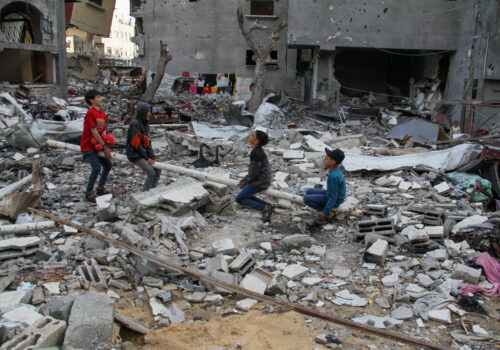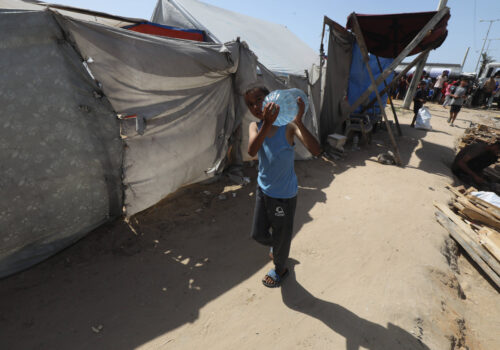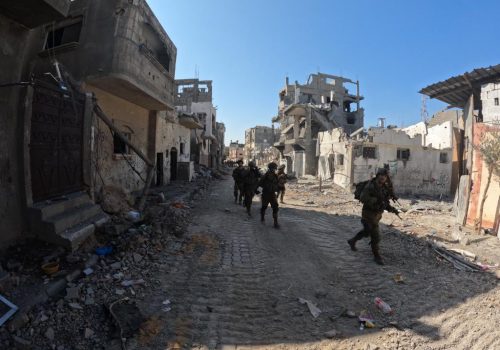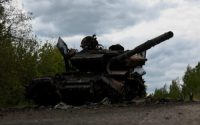Razing the dead: Contextualizing IDF cemetery desecration in Gaza
As Israel’s war in Gaza continues, CNN uncovered a pattern of cemetery desecration throughout the Israel Defense Forces’ (IDF) military advance into the Gaza Strip. The article highlights two satellite images depicting an unspecified Shajaiya cemetery, with the first image showing an aerial view of tombstones dotting either side of a small road. With a click, these tombstones disappear, revealing an image of blown-out buildings and razed earth. Contrasting narratives arise between these images, with enormous implications for how military personnel, policymakers, and the public interpret the conflict and its security and humanitarian ramifications.
Cemetery desecration and Gaza
Responding to CNN’s identification of sixteen such scenes from around Gaza, the IDF offered two explanations. First, the organization explained the military necessity for the operations, accusing Hamas of using cemeteries for military purposes, an accusation the Israeli military has levied before. In 2007, an Israeli airstrike destroyed Sheikh Radwan Cemetery. Accounts of the strike varied, but an IDF spokesperson pinned the destruction on “secondary explosions” caused by a Hamas arms dump and rocket-launching site nearby. The IDF also provided video evidence of an alleged Hamas rocket launch from an unnamed cemetery during the 2014 Gaza War. In response to these attacks, the IDF shelled cemeteries in Gaza City and Rafah. While CNN could not confirm the alleged usage in the current conflict, Amnesty International has traced Hamas’s consistent use of human shields to 2007, bolstering the IDF’s claims.
Challenging this explanation, some legal analysts have noted that an attack targeting a cemetery would not be automatically legal under international law. Furthermore, the IDF also stands accused of using cemeteries for military operations. CNN discovered a makeshift road for IDF vehicles cutting through a bulldozed cemetery, and Scripps News provided evidence of this practice at multiple locations, with advance teams clearing graves as IDF vehicles approached to allow for quicker passage through the cemeteries. CNN also found indications at other sites that the IDF has used Palestinian cemeteries as staging grounds, “leveling large swaths and erecting berms to fortify their positions.”
SIGN UP FOR THIS WEEK IN THE MIDEAST NEWSLETTER
The IDF’s second claim addresses the ongoing Israeli hostage crisis in Gaza. The IDF stated that its mission to find and return the estimated forty-three bodies of deceased Israeli hostages necessitates the exhumation of various sites, including Palestinian cemeteries.
Contrasting the IDF narrative are several reports demonstrating that the IDF improperly handled Palestinian bodies in those cemeteries. In the process of extracting corpses, the IDF reportedly damaged tombstones and left body parts exposed. Moreover, according to one Palestinian doctor, the IDF did not record information about the bodies’ identities or locations while exhuming, posing challenges for officials and Palestinian families trying to claim their dead. Instead, reports show that the Israeli government verified that the bodies did not belong to Israeli hostages and then returned the 180 exhumed Palestinian corpses to southern Gaza, where they now wait in mass and anonymous graves for DNA testing and repatriation.
Cemetery desecration and history
Cemetery desecration is not a new phenomenon, having featured in several conflicts and genocides over the past century. Indeed, the IDF’s first explanation for attacks on cemeteries fits into a pattern of militant tactics in a couple of Middle East conflicts.
In the 2003 Battle of Najaf, al-Mahdi troops in Iraq used Wadi al-Salaam (Valley of Peace), the world’s largest cemetery, as cover to wage war on US forces. More than a decade later, the Kurdish Workers’ Party (PKK) began employing a similar tactic, constructing eighteen cemeteries around southwest Turkey and allegedly using the sites as bases and hideouts to further their fight against the Turkish government. In response, Turkey ordered the sites’ demolition, culminating in government attacks on the cemeteries in 2015.
However, the IDF’s alleged treatment of cemeteries outside of direct conflict with Hamas is also noteworthy, given cemetery desecration’s well-established place in the history of genocide. Cemetery desecration and genocide are so intimately linked that Raphael Lemkin, coiner of the term “genocide,” even recommended outlawing the practice in early drafts of the 1948 Genocide Convention. Great Britain and France ultimately rejected the inclusion, largely due to their engagement in cultural genocide as part of colonial projects. Still, the political decision does not diminish the fundamental role cemetery desecration has played in genocide.
For instance, white settlers in the United States frequently desecrated Indigenous burial grounds in a centuries-long campaign of cultural destruction and ethnic cleansing. Likewise, Nazis desecrated and destroyed countless Jewish cemeteries during the Holocaust, often using headstones as construction materials in a blatant effort to excise both Jewish people and Jewish heritage from occupied German territories.
Desecrating Muslim cemeteries in genocide is also nothing new. In the lead-up to the Srebrenica genocide, Bosnian Serbs inflicted mass atrocities against Bosnia and Herzegovina’s Muslim community, including the destruction of thirty-five Muslim cemeteries. Similarly, in China’s genocide of Xinjiang’s Uyghur Muslims, the government has leveled nearly one hundred cemeteries in what the Uyghur Human Rights Project has labeled a “cultural genocide.”
Cemetery desecration and peace
The parallels between cemetery desecration in these historical examples and the current conflict are cause for considerable concern. Hamas is likely using cemeteries for military purposes, and Israel has the right to respond in line with the fundamental principles of international humanitarian law. However, the alleged IDF practice of razing these sites for military operations, as well as the destructive exhumations of Palestinian bodies without diligent cataloging, is unacceptable and demands further attention.
The conflict in Gaza highlights the dire need to revisit colonial-era shortcomings in understanding and addressing the crime of genocide. Humanitarian organizations will—and should—prioritize living individuals suffering from conflict. But helping the living is not mutually exclusive with preserving the lineage and history tying a community to a conflicted territory.
When the IDF razes Gazan cemeteries, it also razes Palestinian heritage, culture, and claims to the land. This fact is often lost in conversations about long-term security and postwar peace. Ending a conflict goes beyond merely fighting militants in a graveyard to gain one strategic position after another. Israel implicitly acknowledges this fact in vocalizing its mission to reclaim all Israeli hostages, both living and deceased. But any path toward an enduring peace will require not only security for the living, but also assured dignity for the dead.
Charles Johnson is a Young Global Professional with the Atlantic Council’s Rafik Hariri Center & Middle East Programs. He is a junior at the University of Kansas majoring in history, political science, and religious studies.
Further reading
Fri, Apr 12, 2024
Dispatch from Gaza: ‘My son, every night he screams and convulses’
MENASource By Arwa Damon
Arwa Damon arrived in the Gaza Strip on a humanitarian mission for her charity, INARA, two days after the Israeli airstrike on the World Central Kitchen convoy. This is what she saw.
Tue, May 21, 2024
A Rafah invasion might kill peace between Israel and Egypt
MENASource By Shahira Amin
Egypt’s intention to pull out of hostage deal mediation efforts and the continued closure of the Rafah border crossing are alarm bells for Israel.
Tue, Oct 31, 2023
Israel claims it is no longer occupying the Gaza Strip. What does international law say?
MENASource By Celeste Kmiotek
The laws of occupation codify a basic principle of humanity: those with effective control over a population have obligations to protect it.
Image: Palestinians visit the graves of people who were killed in the ongoing conflict between Israel and Palestinian Islamist group Hamas, on the day of Eid al-Fitr, in Gaza Strip, April 10, 2024. REUTERS/Mahmoud Issa





